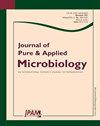Diagnosis of Ventilator-Associated Pneumonia – A Systematic Review and Meta-analysis of Laboratory Techniques
IF 0.7
Q4 MICROBIOLOGY
引用次数: 0
Abstract
Hospitalized patients on mechanical ventilation are at high-risk of developing ventilator-associated pneumonia (VAP), making early and accurate diagnosis essential for the best possible treatment outcomes. This review examined various laboratory techniques, such as aerobic cultures, Gram’s stain, and molecular techniques, to assess how well they diagnose VAP. We have done search strategies using Google Scholar, Medline Complete, and PubMed. Extensive statistical tools were utilized to examine studies and evaluate the diagnostic accuracy of laboratory results. Multiplex PCR was superior to Gram’s stain and culture methods in terms of sensitivity (92%) and specificity (86%). On the other hand, Gram’s stain showed the highest specificity (78.9%) and the lowest sensitivity (74.6%). The results of semi-quantitative, quantitative, enrichment culture showed a lower specificity (75.97%) but a moderate sensitivity (78.5%). The most accurate diagnostic approach for VAP, according to a meta-analysis, was multiplex PCR-based testing, closely followed by culture methods. Beyond separate tests, multiplex PCR, culture, and Gram’s stain combination increased sensitivity. Prompt and precise VAP diagnosis is essential for efficient treatment. With possible improvements through combination diagnostic techniques, multiplex PCR remains the most accurate diagnostic tool. However, more investigation is necessary to improve and certify VAP diagnostic instruments.呼吸机相关肺炎的诊断 - 实验室技术的系统回顾和元分析
使用机械通气的住院病人是罹患呼吸机相关性肺炎(VAP)的高危人群,因此早期准确诊断对于取得最佳治疗效果至关重要。本综述研究了各种实验室技术,如需氧培养、革兰氏染色和分子技术,以评估这些技术对 VAP 的诊断效果。我们使用 Google Scholar、Medline Complete 和 PubMed 进行了搜索。我们使用了大量的统计工具来研究和评估实验室结果的诊断准确性。就敏感性(92%)和特异性(86%)而言,多重 PCR 优于革兰氏染色法和培养法。另一方面,革兰氏染色法的特异性最高(78.9%),灵敏度最低(74.6%)。半定量、定量和富集培养的结果显示出较低的特异性(75.97%)和中等的敏感性(78.5%)。根据一项荟萃分析,VAP 最准确的诊断方法是基于多重 PCR 的检测,其次是培养方法。除单独检测外,多重 PCR、培养和革兰氏染色组合可提高灵敏度。及时准确的 VAP 诊断对有效治疗至关重要。通过综合诊断技术可能会有所改进,但多重 PCR 仍是最准确的诊断工具。然而,要改进和认证 VAP 诊断仪器,还需要进行更多的调查。
本文章由计算机程序翻译,如有差异,请以英文原文为准。
求助全文
约1分钟内获得全文
求助全文
来源期刊

Journal of Pure and Applied Microbiology
BIOTECHNOLOGY & APPLIED MICROBIOLOGY-MICROBIOLOGY
CiteScore
2.00
自引率
0.00%
发文量
266
审稿时长
11 months
期刊介绍:
Journal of Pure and Applied Microbiology (JPAM) is a peer-reviewed, open access international journal of microbiology aims to advance and disseminate research among scientists, academics, clinicians and microbiologists around the world. JPAM publishes high-quality research in all aspects of microbiology in both online and print form on quarterly basis.
 求助内容:
求助内容: 应助结果提醒方式:
应助结果提醒方式:


